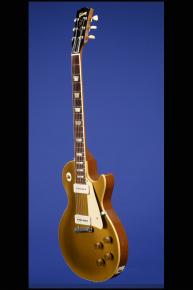A Near Fine and Totally Original 1955 Les Paul Standard Gold Top
This totally original lightweight Les Paul Standard Gold Top weighs just 8.70 lbs. and has nice, fat nut width of 1 11/16 inches and a standard Gibson scale length of 24 3/4 inches. Solid mahogany body with a solid carved maple top, one-piece mahogany neck with a nice, thick profile, and rosewood fretboard with 22 frets and inlaid pearl trapezoid (crown) position markers. Serial number ("5 6594") inked-on in black on the back of the headstock. The top of the guitar has single cream binding and the fretboard has single cream binding. Headstock with inlaid pearl "Gibson" logo and with "Les Paul Model" silk-screened in gold. Two-layer (black on white) plastic truss-rod cover. Individual single-line "no-name" Kluson Deluxe tuners with single-ring tulip-shaped Keystone plastic buttons (stamped on the inside "2356766 PAT APPLD."). Serial number “5 6594” inked-on in black on the back of the headstock. Two beautifully balanced P-90 pickups with outputs of 7.74k and 7.78k. Cream plastic pickup covers stamped underneath "UC-452-F / 1" and "UC-452-B / 2". Single-layer cream-colored plastic pickguard. Four controls (two volume, two tone) on lower treble bout plus three-way pickup selector switch (with original Catalin switch-tip) on upper bass bout. Gold plastic barrel-shaped "Speed" knobs. The potentiometers are stamped "615 4190 440" (IRC October 1954) and the two original capacitors are stamped "Grey Tiger Type GT 452 .02 MFD 400 VDC." Combination "wrap-over" bar bridge/stud tailpiece. This super guitar is in exceptionally fine (9.00) condition. There is some minor finish checking on the top of the guitar. The original owner has etched a very small identification number (not uncommon) on the back of the body just to the right of the heel. The guitar has a long time ago been so expertly refretted with original guauge fretwire that it is almost impossible to to detect. When we fully examined this guitar we noticed that beneath the truss-rod cover there was some evidence of an incorrect truss-rod adjustment tool having been used and this had caused some surface loss to the surrounding area. We sent the guitar to Master Luthier Terry Mueller in Carbondale, IL who has almost invisibly rectified the problem. Housed in the original Gibson four-latch brown hardshell case with pink plush lining (9.25). Together with the original brown leather guitar strap, three original hang-tags incuding: yellow folding "Gibson Les Paul Model"; orange guitar shaped "Gibson Sonomatic Strings", and "Gibson Inc. Professionals Attention". Also an original box of Gibson Mona-Steel strings (containing just a "B" string).
This totally original '55 Les Paul Standard Gold Top -- with a neck and a sound to die for -- is the one of the best that we have ever seen. It has the early "IRC" pots (which were used only between 1949 and 1954) and the "Grey Tiger" capacitors, which preceeded the usual "Bumble-Bees." At just over eight and a half pounds, it is a real lightweight.
Many guitarists consider this to be the ultimate "blues machine" -- the sustain on this guitar is quite unbelievable!
"The first Gibson Les Paul solidbody electric guitar, known simply as the Les Paul Model then but now better known by its descriptive nickname 'gold-top', first went on sale during 1952" (Tony Bacon, 50 Years of the Gibson Les Paul, p. 15).
"The new Les Paul guitar was launched by Gibson in 1952, in the summer, priced at $210, which was about $20 more than Fender' Telecaster sold for at the time…Today, a gold-finish Les Paul model is nearly always called a gold-top thanks to its gold body face…The new gold-top's solid body cleverly combined a carved maple top bonded to a mahogany base, a sandwich that united the darker tonality of mahogany with the brighter sonic 'edge' of maple. Paul said that the gold colour of the original Les Paul model was his idea. 'Gold means rich,' he said, 'expensive, the best, superb'" (Tony Bacon, 50 Years of the Gibson Les Paul, pp. 20-21).
"In 1955 the gold-top gained Gibson's new Tune-o-matic bridge. The unit had the facility to adjust individual string-length, improving intonation. Two years later humbucking pickups replaced P90s on the gold-top" (Tony Bacon and Paul Day, The Gibson Les Paul Book, p. 19). This guitar is one of the last Les Paul Standard Gold Tops with "wrap-over" bar bridge/stud tailpiece before the Tune-O-Matic bridge was introduced in late 1955.
Translate:












